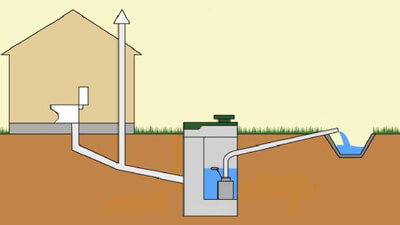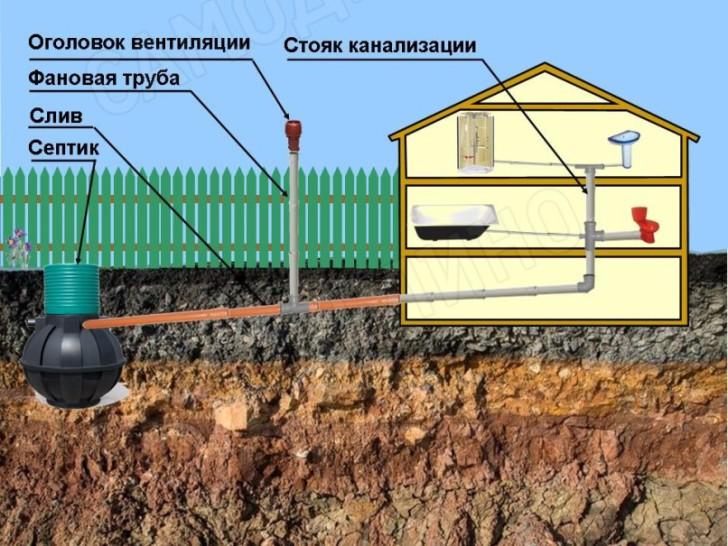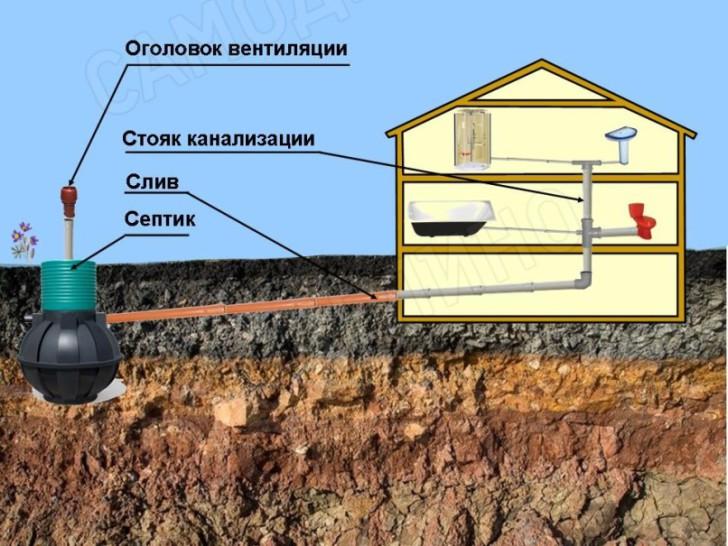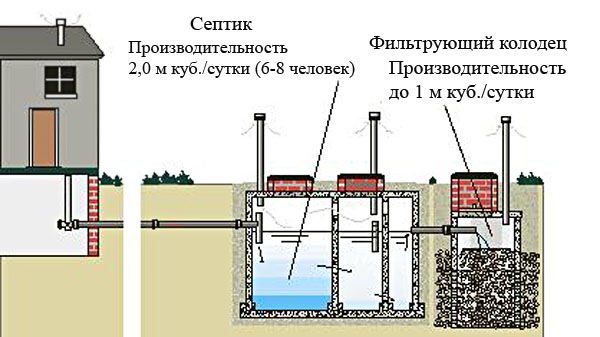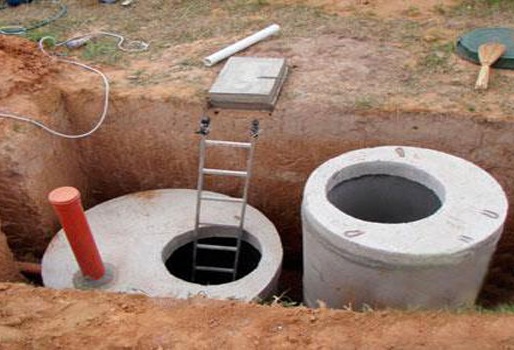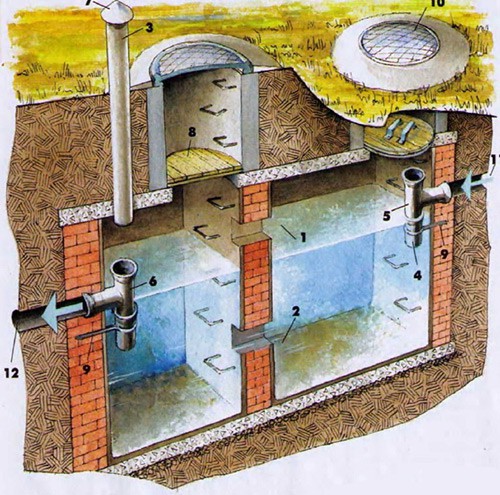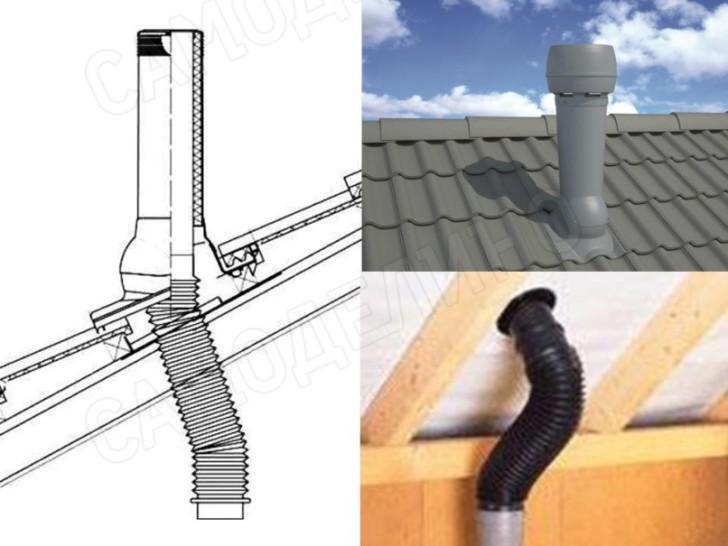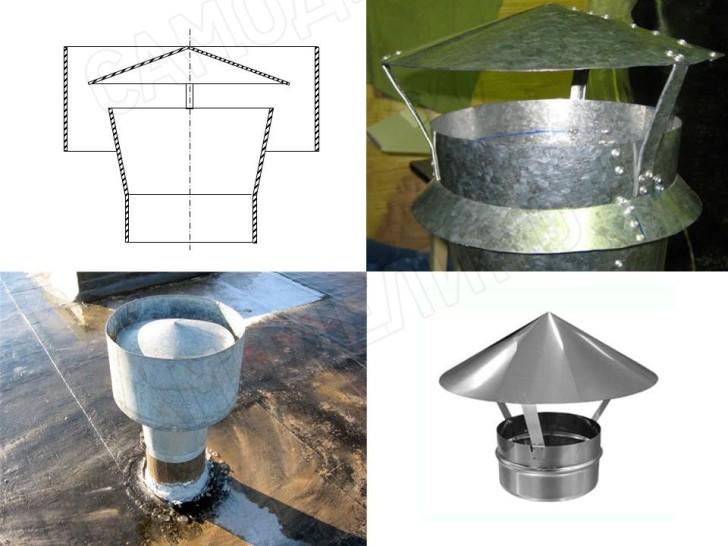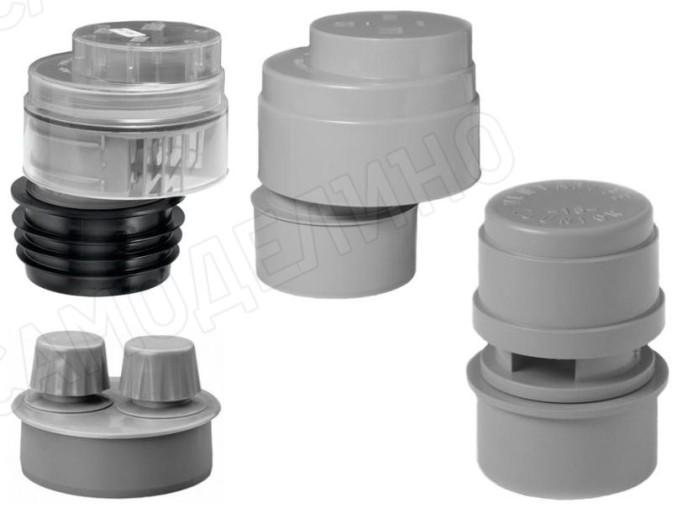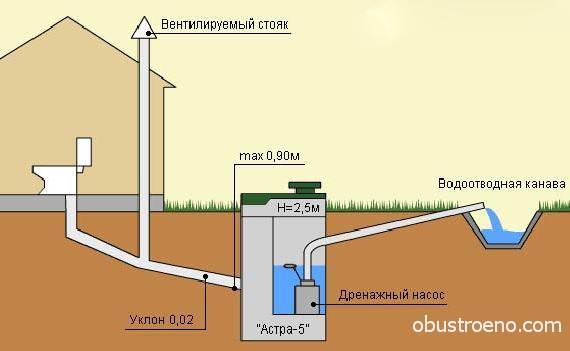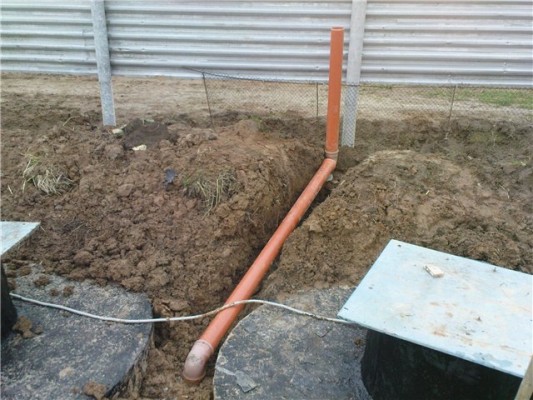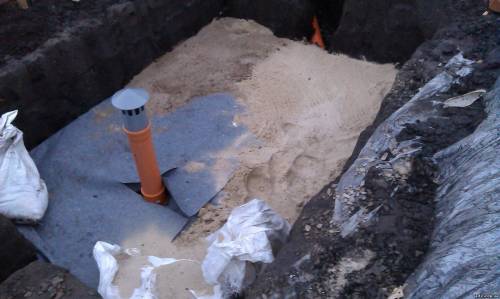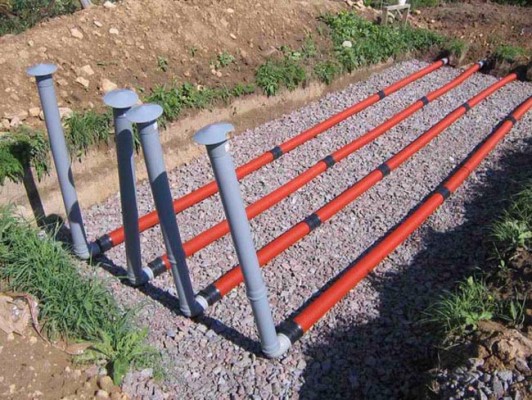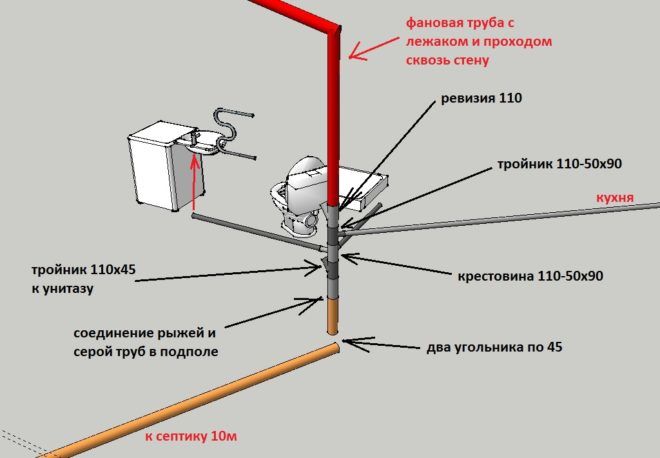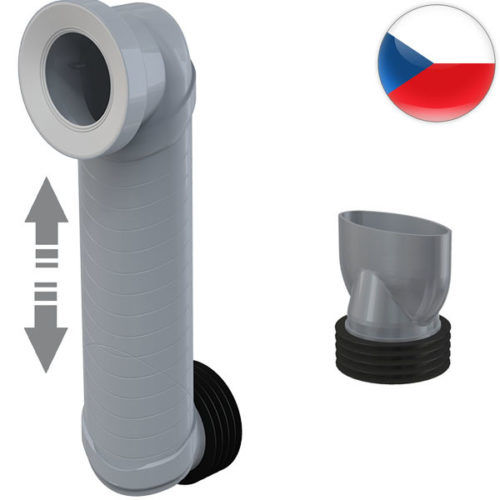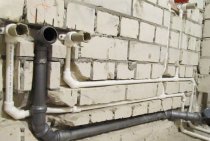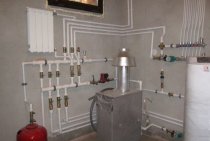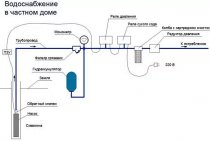Preparatory actions before installation of equipment
Primary actions always begin with the purchase of plumbing equipment, building materials and the necessary tools.
For the installation of sewage, pipes made of PVC are selected, which are most suitable in terms of their characteristics and price. They are most often used in the installation of sewerage due to the long service life and high manufacturability in the installation of risers and the overall system. Along with pipes, sealed gaskets for connections are purchased, as well as adapters, tees and couplings.
Sewerage work is carried out with the simultaneous installation of ventilation elements.
- installation of special valves to relieve the pressure of accumulated gases in the sewer;
- installation of a background pipe on the roof of the house;
- septic tank ventilation.
Sewer ventilation schematically.
Mounting options for outdoor ventilation system
If the project documentation of the house does not provide for a sewer hood device, after putting it into operation, it is necessary to equip an external ventilation system. The pipe connected to the drain is brought out and mounted in a convenient place for its location. One of the options for placing the ventilation pipe is to strengthen it on the outer wall of the house. The connection is not made to the riser, as with an internal ventilation device, but directly to the wastewater drain.
An outdoor chimney can be mounted on a fence, a wall of an outbuilding, or other vertical surfaces. With this type of installation, it must be borne in mind that a disgusting smelling miasma is emitted near the outlet, and the exhaust pipe should be located in such a way that the bad smell does not create inconvenience to neighbors in the area.
For the owners of country houses, the simplest and at the same time effective installation option is to install an exhaust pipe directly into the fecal pit.
It is always located away from living quarters, so the bad smell will not bother the household. The height of the pipe above the ground may not exceed one meter.
Often, owners of small houses doubt that sewer ventilation is advisable, assuming that it will not function in the hot season during a period of especially intensive decomposition of organic matter. These doubts have no basis, since the wastewater temperature will always differ from the ambient temperature, as a result of which a pressure difference arises, and air and heat exchange will occur.
A properly installed exhaust pipe ensures comfortable living by preventing the fetid smell of sewage from entering the living quarters. Probably, the owners of private houses can be creative and come up with a variant of the hood of their own design. The main criterion is that she cope with the tasks assigned to her, and the household did not complain about the author of the project. The following is a video that provides useful information about installing a fan riser.
Any person living in a private household has at least once encountered a problem when, in strong winds or hot weather, “ambergris” from the sewer penetrated into the dwelling. The gases formed as a result of the decomposition of organic matter smell unpleasant. In addition, you are probably familiar with sewer gurgling and "champing" when draining sewage. This is due to a change in pressure in the sewer system and the formation of vacuum plugs. All these troubles are eliminated in a private house.
Ventilation is necessary for any type of sewerage: centralized, autonomous, isolated or non-isolated.It will not only provide the required volume of fresh air, but also balance the pressure of the system, due to which the drains will merge silently. The sewer hood should ideally be designed during construction in a private house
In practice, it happens that attention is paid to its arrangement only when guests make a comment about the fragrant persistent aroma in the room or on the site.
Do I need ventilation in a septic tank?
The range of hermetic tanks for the processing of domestic wastewater is huge: in addition to various industrial models, from a simple storage tank to a biological water treatment plant, there are many artisanal types made of concrete, brick and plastic.
One of the options for a three-chamber septic tank
The most effective structures consist of 2-3 parts:
- in the first, sedimentation of sewage occurs with precipitation and fat floating;
- in the second - additional purification of already clarified liquid;
- in the third - the final filtration.
Factory models are initially equipped with equipment that provides air movement. The fact is that the main mission in the cleaning processes is performed by bacteria. It is on their work that the characteristics of purified water depend, as well as the ability to use it in the future (for washing a car, watering a garden, etc.). Some bacteria - aerobic - cannot process biological waste without the presence of oxygen. Therefore, it is necessary to ensure the flow of air. Compounds of various chemical elements, including oxygen, form gases with an unpleasant odor. Some of them (for example, methane) are dangerous for people and animals.
Conclusion of the ventilation outlet in a concrete septic tank
Home-made devices, made according to the simplest schemes, are most often ventilated naturally - through the slots of the hatch or a gap in the sewer pipes. What does this lead to? Firstly, to the spread of unpleasant "exhausts" from under the hatch cover, and secondly, to the appearance of the same specific smell inside the building. Poisonous gases that have entered a residential building signal its unsuitability for habitation.
It turns out that the correct ventilation device for a septic tank in a private house solves two important problems: it increases the efficiency of the treatment plant and eliminates the danger of poisoning with harmful gases. There are several ways to arrange hoods:
- installation of pipes that ensure the flow of air into the tank and return from it;
- application of a set of vertical risers for air inflow on the drainage field;
- installation of a vent pipe inside the building.
The safest is the integrated use of all methods, however, for a small cottage that operates only in the summer, one is enough.
Scheme of the device of the ventilated chamber
Tasks to be solved
The septic tank is a kind of drain collector, into which everything that we strive to get rid of in the toilet, in the kitchen, etc., enters through the drainage riser. This is a continuous process, because on a rare day we do not use the toilet, shower, etc. In order for the diversion mechanism to “work like clockwork”, the ventilation of the cesspool must be well established. It must be done in such a way that at least two tasks are successfully solved:
- The absence of "leakage" of an unpleasant odor into rooms where it is not expected at all (toilet, bathroom, kitchen, etc. rooms).
- Ensuring continuous and high-quality waste disposal through a septic tank.
The latter condition determines the success of the actions of bacteria living in the drain collector. After all, it is they who perform the function of processing the mass of waste, decomposing it into gases, purified water and sludge. They operate in two groups:
- anaerobic, capable of making methane from what enters through the drain into the thickness of the slurry of the 1st chamber of the septic tank (household waste of various origins);
- aerobic, "eating up" from the surface of the liquid what is left after the first group, and releasing hydrogen sulfide.
The device of a two-chamber septic tank
In addition to these gases, other volatile compounds (phosphorus, arsenic, etc.) are also present in the "exhaust". What can this lead to? If you do not make ventilation in such a volume filled with gases or make it insufficiently effective, then the products produced by bacteria will begin to flow through the sewer back into the house (toilet, bathroom, kitchen, etc.). In a favorable case, this will lead to an all-pervading atmosphere of stench, and in a less fortunate one, to an explosion, quite possible due to the presence of methane.
Hoods for sewerage
Frequent 2 mistakes
There are at least two common misconceptions about such devices:
- Since I have a fan pipe in my house or apartment, that is, ventilation of the sewer riser (bed), it means that all unpleasant odors from the system should come out through it
. However, we are very surprised if this does not work. But the thing is that the most common source of stench is either damaged pipes, or the absence of hydraulic valves due to the banal non-use of any bathroom (a column of water can evaporate). - But the second mistake concerns the residents of the upper floors who have access to the fan pipe - when repairing or replacing plumbing equipment in the toilet or bathroom, it is removed altogether
. The reason here is the poor condition of this pipe - due to the long service life, they are pretty damaged by corrosion. But by drowning out the riser, you create a problem not only for yourself, but also for all your neighbors living below on all floors. The smell will penetrate into the apartments with each descent of the toilet.
Let's start with the fact that ventilation from sewer pipes in a private house, especially if there is more than one toilet, should be at least 4 m above ground level. As a rule, the fan pipe is led out through the roof. This will keep the water in the hydraulic seals from evaporating too quickly, and will also allow you to compensate for the difference in air pressure when flushing a toilet bowl or two toilet bowls at the same time from the cistern.
When the water is drained from the toilet, its volume completely fills the diameter of the pipe and, when moving, rarefies the air after it, which leads to the exhaustion of these same water seals. But the fan pipe compensates for this difference. As a result, you get the absence of unpleasant odors in the room.
I have already said about the diameter - it should be the same as in the system itself. But is it possible to use pipes from another material, for example, to combine the laying of a PVC system with an asbestos-cement or metal fan riser?
The answer here in any case will be unequivocal - yes, you can. Only in this case, another question arises - is it necessary? It is best to use polyvinyl chloride for a fan riser, even if your wiring is made of metal or asbestos cement (it happens) - PVC is very light, strong, and its service life is 50 years or more.
The ventilation insert is made at the highest point of the sewer system, made from the widest pipe. That is, if the main system has 110 mm, then the connections to it will be made from a diameter of 50 mm, but they, of course, will be higher, although it is desirable to make a tie-in on the 110th pipe (you can also on the 50th, but the effect is diminished ). Most often, this point is the connection point of the toilet.
One of the options is to bring ventilation through, as in the top photo - this will most likely increase the price of the structure, but this option is quite convenient.Such a letter G should be made with the same material as the system itself, and the riser can already be mounted from PVC.
Construction and maintenance
The ventilation ducts are carried out at the final stage of the installation of the septic tank. About what and how to make the latter, there are many descriptions. Ventilation of a septic tank made of concrete rings (this is one of the typical construction methods, distinguished by reliability and availability) will become possible, on the one hand, due to the presence of a pipe diverted from its second (last) chamber (but not from the first), and on the other hand, behind account of the risers provided at the starting point of the sewer system, providing compensation for the vacuum.
In the presence of filtration fields, drains should also be equipped with ventilation pipes. The latter will be able to additionally serve as viewing windows and places for flushing. The pipe diameter is generally ~100 mm. As for air circulation, it goes according to the scheme:
- inflow through the second (if there are more of them - the last) chamber;
- passing through the connecting pipes and the riser upwards (the appearance of gases is accompanied by an abundant release of heat, and it contributes to just such a direction of flow);
- exit through a riser located at some elevation above the roof of the building (fan).
What can block the free flow of air? In order for gases to pass through the system unhindered, it is necessary to fill the pipes from 1/3 to 2/3 of the inner diameter, no more. To improve traction, as well as to prevent precipitation from getting inside, it is required to equip the upper ends of the risers with protective caps.

Scheme of treatment facilities
At the same time, a number of precautionary measures relating to safety must be observed. Here they are:
- there must be at least two attendants;
- it is necessary to use personal protective equipment against falls;
- Smoking is not allowed in work areas.
If you do not want the products sent from the toilet through the toilet bowl and cistern to poison your life, returning already in gaseous form, be sure to provide and ensure optimal operation of the ventilation system for your septic tank. This will not only save your nerves, getting rid of the stench, but maybe even save your life.
Ventilation outlet through the roof
It is not recommended to leave the outlet of the sewer exhaust pipe in the attic, as it is not properly ventilated, and the smell can penetrate into the house. The pipe must be pulled through the roof. The work is performed in the following sequence:
- the laying of the exhaust pipe is completed in the attic;
- the end section of the pipe is fixed on the roof surface;
- using a corrugated adapter, two pipe sections are connected.
The end section of the pipe is fixed on the roof surface with the help of a flexible and elastic adapter made of polymeric material. Its cuff is sealed and securely fastened with screws or other fasteners. It is easiest and most reliable to use a factory-made ventilation outlet for installation on a roof, designed for a specific type of roof.
Under normal conditions, the warm air that exits the ventilation duct does not allow freezing of the sewer ventilation outlet. Note that in regions where the temperature in winter can drop below thirty degrees, ice freezes and clogs the ventilation outlet. In this case, it is necessary to insulate both the section of the ventilation duct in the attic of the building and its exit on the roof.
How to make a fan pipe deflector with your own hands
A deflector is installed at the outlet of the fan pipe. This is done to increase the efficiency of natural thrust due to the aerodynamic properties of this structural element. The deflector increases the draft in the chimney by about thirty percent.You can buy a ventilation deflector, or you can make it yourself. To perform this work, you will need the following materials and tools:
- small galvanized sheet;
- hardware for fasteners;
- metal scissors;
- tape measure or ruler;
- carpenter's pencil.
A cone-shaped bell is marked on a sheet of metal. The section below should correspond to the diameter of the ventilation pipe, from above this parameter increases by approximately fifteen percent. A skirt is placed in the middle part of the metal cone, and a visor in the form of an umbrella is placed on top. All parts of the resulting structure are fastened with rivets, self-tapping screws or screws with nuts and installed on top of the outlet pipe.
Alternative option - vacuum valve
A vacuum or aeration valve designed to equalize pressure is a very conditional alternative to full-fledged ventilation equipment. It is installed when it is impossible to withdraw the fan pipe (due to the design features of the building), complex wiring of sewers, and so on.
The vacuum valve consists of a soft spring and a sealing seal. The principle of operation is not complicated: when the pressure inside the sewer decreases, the valve opens and lets in outside air. After equalization of external and internal pressure, the valve closes.
In addition to the upper outlet of the sewer riser, vacuum valves are installed on horizontal sections of the pipeline network between plumbing fixtures connected to it. Their location and number depends on how many drain points are in the house and how they are located.
With an increase in the operating time, contamination is deposited on the valve parts, the tightness is broken, so the aeration valve needs periodic cleaning, that is, maintenance is required. In addition, the mechanism works reliably only at positive ambient temperatures, and at negative temperatures, the operation is disrupted.
Building codes and regulations do not regulate the operation of such devices in any way, therefore they are installed exclusively by owners of private houses.
The main issues related to the aeration plant
Most often, people living in private households have doubts or questions regarding the creation of a ventilation system in their sewers. The main topics are:
Will ventilation cope with its functions in the hot summer, during the maximum decomposition of organic waste?
Yes, it will. This is due to the difference in external and internal temperatures between the treatment plant and the environment, due to which there is a constant heat and air exchange. The sewer water temperature will always differ from atmospheric air. This factor also contributes to the creation of a pressure difference in the installation and its effective ventilation.
Will the riser, which is an uninsulated (non-insulated) part of the structure, freeze in winter?
In winter, wastewater is always warmer than air, so the riser cannot freeze over with regular use of the treatment plant. In some regions, the riser facing the street should be insulated (insulated). For this, a pipe with a large diameter is used. For more detailed information, it is better to contact professionals.
Some time after the installation of aeration, odors began to penetrate into the rooms. Why?
Siphons filled with water tend to dry out, letting in an unpleasant odor
. This happens if the sewer has not been used for a long time: the riser accumulates rarefied air. There are several ways to solve: change (increase) the volume of siphons, install fan pipes or an aeration valve on the riser. The valve will allow you to efficiently conduct atmospheric air inside and prevent air discharge in the pipes.
6054
Sewer ventilation and 2 mistakes made during repairs
July 7, 2016
Specialization: master of interior and exterior decoration (plaster, putty, tile, drywall, wall paneling, laminate, and so on). In addition, plumbing, heating, electrical, conventional cladding and balcony extensions. That is, repairs in an apartment or house were done on a turnkey basis with all the necessary types of work.
Sewer ventilation scheme in a private house - a fan pipe exits through the roof
Clean air in a residential area will always be one of the first needs, therefore, sewer ventilation in a private house - created by oneself, is one of the conditions for installing plumbing. In addition, in some cases, ventilation must be equipped in apartments in multi-storey buildings.
I will now tell you how this is done, and I also want to invite you to watch the video in this article.
Principle of operation
The work of a septic tank practically occurs differently in each case. The water clarified during the passage of the septic tank must leave constantly, because the septic tank is also constantly replenished. In fact, a slightly different process often occurs - the septic tank works as long as the water fills the tank. This often happens when there is a misunderstanding of the fact that one septic tank is not enough for the successful operation of the sewer. The removal of clarified drains must be ensured, the ventilation of the septic tank must work. It is assumed that when using an expensive imported septic tank with aeration, it is possible to discharge effluents into nearby water bodies.

How a septic tank works.
With a water consumption in the house of less than 1 m³, the septic tank will be filled in just a couple of days. The clarified water should go by gravity through the outlet pipe. Usually the water goes to the drain pipe, then to the ditch or to the filtration fields. Acting in small portions, wastewater in a properly calculated septic tank should be kept at the same level. This level should be such that the discharge pipe can operate optimally.
It is known that for any sewer pipe, the optimal filling is 1/3 of the diameter. That is why pipes with a diameter of less than 100 mm are unsuitable for external sewage. This also applies to the outlet pipes from the septic tank. We can assume that the choice of the diameter of the outlet pipe of the local sewer has already been made, 100 mm is the necessary minimum. Theoretically, it never hurts to increase the diameter of the outlet pipe.
The problem will be to find a drainage pipe for sale for a large diameter resorption field. If desired, you can make it yourself, make the appropriate cuts in an ordinary sewer pipe. On the Internet, you can find any recommendations for such owners who want to make drainage pipes more efficient. Usually, the outlet pipe from the septic tank quickly silts up, but it is also not always possible to make it larger, since finished septic tanks have outlet pipes of certain sizes.
Do-it-yourself ventilation of a septic tank from concrete rings
A popular model of a homemade septic tank among summer residents is a tank made of concrete rings. The structure resembles a cesspool, only, unlike it, it has access to a filter chamber or a drainage field. A more efficient design consists of two chambers, if desired, both containers can be equipped with separate hoods. The more actively air enters the treatment plant, the faster the biological treatment process will take place.
Common side outlet for ventilation
Consider how to arrange ventilation in a concrete septic tank, or rather, in the most successful design, consisting of two chambers and a filter well. Either two chambers or all tanks are equipped with air inlets and outlets. The process proceeds as follows:
- we prepare segments of the required length with a cross section of 110 mm;
- in concrete covers with which the chambers are closed from above, we drill holes of the same diameter;
- we insert the elements into the holes intended for them (the lower part should not touch the drains, we raise the upper part to the maximum possible height);
- we fix each part with sealant, mastic or cement mortar;
- We equip the upper ends with a protective cap.
End caps prevent debris, water and snow from entering the tank and enhance air draft. Of course, any cleaning equipment requires maintenance from time to time. In this case, the removal of solid waste and elimination of blockages. At the same time, they also clean the pipe for ventilation. Considering that gases are dangerous (they are a necessary result of biodegradation), be sure to use a safety harness and a respirator. It is best to carry out all work under the supervision of an assistant.
Outer pipe in a concrete septic tank cover
If a drainage field is provided at the summer cottage, external outlets are placed along it - they give air access to the drains and remove the formed gases to the outside. More often, drains (perforated pipes, from which drain water goes into the ground), are simply bent, brought to the surface and equipped with caps. Such devices play the role of technical holes, with their help you can check how the system is functioning. If water has accumulated in the lower part, the drains do not have time to soak into the ground, a clean bottom indicates the proper operation of the sewer.
Ventilation device on the drainage field
As you can see, the correct septic tank ventilation device brings noticeable benefits: it activates the wastewater treatment and prevents the appearance of an unpleasant odor. By doing all the work yourself, you can save on installation, but if you are not confident in your abilities, contact a specialized company.
Installation of a fan pipe
Effective ventilation of the riser of the sewer system is formed using a fan pipe. It is a kind of continuation of it. The principle of operation of the fan pipe is quite simple. Warm air inside the sewer riser rises to the outside. A kind of traction is formed in the system. It helps draw air out of the room. Therefore, unpleasant odors can leave the sewer system. As a result, the comfort of the owners will not be disturbed.
When constructing a sewer riser using a vent pipe, the following rules should be followed:
- rises above the roof level by 500 mm (more is allowed);
- the diameter of the exhaust system must correspond to the diameter of the sewer riser;
- if there are 2-3 sewer risers, they can be connected at the top point and exit through a single fan pipe;
- it is strictly forbidden to combine a sewer hood with a stove or building ventilation;
- it is not advisable to install a fan pipeline near windows, balconies. This will lead to the spread of an unpleasant odor inside the building. The fan pipe moves away from the windows at a distance of 4 m;
- in the presence of a multi-pitched roof, it is forbidden to bring the ventilation pipeline under the slopes. It can break under the weight of the snow cover;
- it is not recommended to install a deflector on the upper cut of the hood. There is a possibility of condensation. The resulting liquid freezes in winter at sub-zero temperatures, which will significantly reduce the efficiency of the hood;
- the fan pipe is made from materials used for the production of sewer risers. Cast iron quickly breaks down under the influence of the environment. Its use is not allowed.
Do I need ventilation of the internal sewerage
Existing building codes and regulations make it possible not to equip ventilation in the internal sewerage of houses with a small volume of wastewater discharge. In this case, the height of the building should not exceed two floors.In the event that the total volume of wastewater exceeds the diameter of the receiving sewer pipe, ventilation is mandatory even in a one-story house.
As an example, imagine that the toilet drain pipe is eight centimeters in cross section, and the riser is twelve centimeters. If you flush the water from one toilet, the riser will not be blocked by the flow of liquid, but if you flush from two toilets at the same time, the sewer will overflow. Thus, it is possible to foresee the likely discharge of wastewater by possible plumbing fixtures and understand whether it is necessary to equip the exhaust of the internal sewerage. It is required in the following cases:
- if the section of the riser is less than or equal to five centimeters;
- toilets and sinks are located on all floors of a building with a height of two or more floors;
- the house has a large bath;
- on the site there is an artificial reservoir in the form of a pond or pool.
The reason for the occurrence of an unpleasant odor can also be the drying of water in the siphon water seals.
In the design of these elements there are curved tubes that must always be filled with water to prevent sewer gases from escaping to the outside. If there is no water in the water seal, the living quarters of a private house are filled with miasma.
If such a problem occurs during a long absence of residents, to prevent the spread of smell from the sewer, pour a little vegetable oil into the appropriate drain hole. Then the water in the water seal will not dry out, and the problem will not arise.
Ventilation schemes
When sewer ventilation is planned when designing a house, it is most often done inside the house. In this case, the riser is brought to the roof in the form of a fan pipe. It is, as it were, a natural extension of it. The diameter of both pipes must match (if the riser is 110 mm, then the fan pipe is 110 mm). The ventilation duct is thought out in such a way that the fan pipe is located at a distance from the windows (at least 4 meters) in order to timely naturally eliminate unpleasant odors.
The height of the fan pipe above the roof depends on the type of roof and varies from 0.2 to 3 meters. Its height is regulated by the set of rules SP 30.13330.2012. For example, for a flat roof of a country house, at least 300 mm of elevation is required, and for a pitched roof, about 500 mm. From above, ventilation is equipped with a deflector, which acts as a sewer protection against the penetration of precipitation and to enhance air draft. In general, the deflector increases the efficiency of the ventilation system in the house.
Experts do not recommend connecting the ventilation riser to the pipes of the chimney or the common house exhaust system.
But it can combine approaches from several sewer risers. When the vent pipe is led out sideways (into the wall), it is not placed under the roof overhang, since there is a great danger in winter that the outlet will be disrupted by an array of snow or ice. It is also recommended to hide the outlet opening behind a decorative rosette.
Purpose of ventilation
Ventilation of the sewer system is intended to solve the following problems:
- elimination of unpleasant odors from plumbing fixtures;
- elimination of gases (hydrogen sulfide and methane) generated during the decomposition of waste in a septic tank (cesspool). Gases can harm people's health (severe poisoning) and lead to an explosive situation;
- balance the pressure inside the sewer pipes. When draining water simultaneously in several plumbing fixtures, it leads to insufficient air in the sewer system and, as a result, the formation of a pressure difference. Timely air supply will help eliminate this problem and keep the installed water seals intact.
